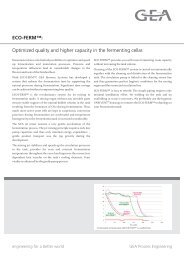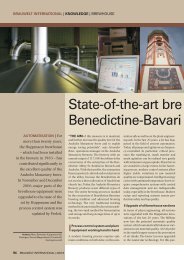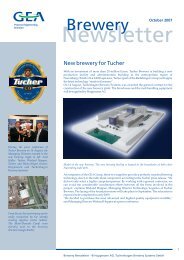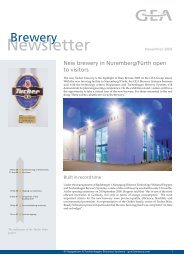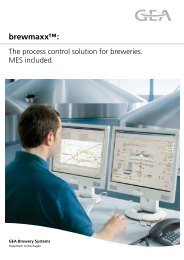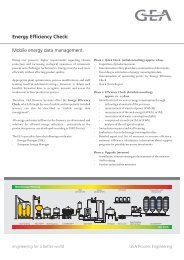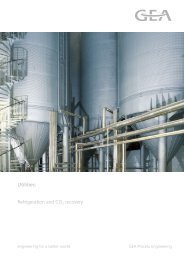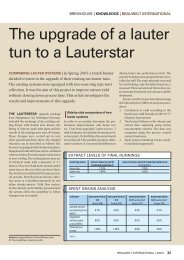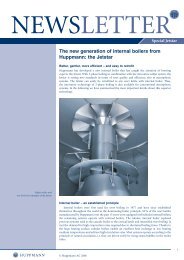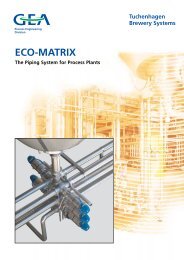Conserving resources, - GEA Brewery Systems
Conserving resources, - GEA Brewery Systems
Conserving resources, - GEA Brewery Systems
You also want an ePaper? Increase the reach of your titles
YUMPU automatically turns print PDFs into web optimized ePapers that Google loves.
<strong>Conserving</strong> <strong>resources</strong>,<br />
reducing energy costs.<br />
<strong>GEA</strong> <strong>Brewery</strong> <strong>Systems</strong><br />
Huppmann Tuchenhagen
Energy and environment are in the focus ...<br />
FACTS & FIGURES<br />
Exploring the opportunities together<br />
Determining the energy savings<br />
potential in your brewery requires direct<br />
communication. With our extensive<br />
experience we can make specific<br />
optimization suggestions. We mostly work<br />
out optimization programs with several<br />
stages, so that you can make production<br />
more efficient step by step and monitor<br />
the ROI at any stage.<br />
2
... we provide optimum system solutions.<br />
Increasingly, we are all facing rising energy<br />
costs, stricter environmental regulations or even<br />
taxes on energy or emissions.<br />
There are many ways to address the rising<br />
costs in the field of energy management and<br />
environmental technology. With consistent and<br />
structured optimization of brewing technology<br />
and plant equipment it is possible to cut energy<br />
costs and to meet legal requirements in a<br />
commercially reasonable manner.<br />
Each energy management project begins with<br />
an assessment of the current state of the brewery<br />
with respect to energy and material flows. Our<br />
experience shows that there is great potential for<br />
optimization particularly in the brewhouse, which<br />
is the biggest consumer of thermal energy in the<br />
brewery with a share of 40 %. In every section<br />
of the brewery we determine all relevant specific<br />
consumption figures.<br />
This is the basis of our concept for the<br />
optimization of the processes and the associated<br />
equipment as requested by the customer.<br />
What exactly has to be done in order to cut<br />
energy consumption and costs, to reduce water<br />
consumption and waste water production and<br />
to decrease emissions? Of course, economic<br />
efficiency calculations are also taken into account.<br />
In all optimization efforts the quality of the beer<br />
is always the number one priority.<br />
Our program includes:<br />
■■Technological consulting<br />
■■Energy technology and management<br />
■■Refrigeration and heat technology<br />
■■Fresh and waste water solutions<br />
■■Process control technology incl. data acquisition<br />
■■Measurement and control technology<br />
■■Project management with cost control<br />
Huge savings potentials<br />
The diagram shows the specific energy<br />
consumption of breweries compared to<br />
their annual output. The amount of energy<br />
required for a comparable output varies<br />
considerably. In other words, with the<br />
same amount of energy it is possible to<br />
obtain an output that is higher by a factor<br />
of 10. Today, the breweries that produce<br />
their output efficiently with minimum<br />
energy consumption are setting the<br />
standards. Whether large or small – with<br />
intelligent energy management and stateof-the-art<br />
plant engineering, any brewery<br />
can save considerable amounts of energy,<br />
produce more efficiently and conserve<br />
<strong>resources</strong>.<br />
3
Dyn. LPB – the more efficient system in the brewhouse.<br />
The principle of dynamic low-pressure boiling<br />
(dyn. LPB) developed by <strong>GEA</strong> <strong>Brewery</strong> <strong>Systems</strong><br />
provides considerable advantages in terms of<br />
energy consumption, particularly in combination<br />
with the JETSTAR and the energy storage<br />
system (ESS). This is confirmed by the comparison<br />
with conventional wort boiling systems, which<br />
normally require a total evaporation rate<br />
of up to 8 % to ensure the desired wort<br />
quality.<br />
A total evaporation of 4.5 % leads to an energy<br />
balance in the brewhouse. All the energy recovered<br />
from the vapours is used to heat the lauter wort<br />
of the next brew up to 94 °C. Higher evaporation<br />
rates are possible if there is a continuous demand<br />
for hot water in other sections of the brewery.<br />
Thus, the energy storage system contributes<br />
significantly to the reduction of CO 2<br />
emissions from the brewing process.<br />
Energy storage tank<br />
Vapour<br />
condenser<br />
Whirlpool<br />
Wort kettle<br />
Pre-run tank<br />
FACTS & FIGURES<br />
Heat exchanger<br />
JETSTAR<br />
atmospheric<br />
without ESS<br />
Dynamic low-pressure<br />
boiling<br />
with JETSTAR and ESS<br />
Conventional<br />
boiling<br />
without ESS<br />
Total evaporation 3.5 % 4.5 % 5 % 6 % 8 %<br />
Heat recovery<br />
at vapour condenser [kWh/hl cold CW]<br />
Spec. electrical energy<br />
at vapour condenser [kWh (el)/hl CW]<br />
Hot water production<br />
with 80 °C [hl/hl cold CW]<br />
Spec. heat consumption<br />
[kWh(H u)/hl CW]<br />
Spec. total emissions<br />
[kg CO 2/hl CW]<br />
Data for 10 t grist load, 536 hl cold CW, 13.5 °P<br />
2.073 2.665 2.961 3.553 4.739<br />
0.006 0.018 0.019 0.021 0.008<br />
0.296 0 0.050 0.131 0.678<br />
8.807 6.780 7.142 7.866 12.183<br />
1.89 1.47 1.54 1.69 2.60<br />
Energy storage system in 3D<br />
The above illustration shows all major<br />
components of an energy storage system.<br />
The system is supplied by a vapour<br />
condenser, where the vapours produced<br />
are condensed. The hot water produced<br />
during one brew is stored in the storage<br />
tank and used to preheat the next brew to<br />
boiling temperature.<br />
Energy in balance – sustainable and<br />
efficient.<br />
In order to ensure that lower total<br />
evaporation rates do not affect the<br />
beer quality, we provide the JETSTAR<br />
boiling system which achieves excellent<br />
homogeneity in the wort kettle and thus<br />
enables intensive conversion processes.<br />
Together with dyn. LPB, efficient stripping<br />
of undesirable aromas is guaranteed. The<br />
amount of hot water produced can be<br />
adapted to individual requirements. With<br />
a rate of 4.5 %, the system is optimally<br />
balanced – without excess hot water.<br />
4
Preventing emissions in the brewhouse.<br />
The brewhouse is an interesting target for<br />
optimization, not only because of the high energy<br />
consumption. Brewers are also often under<br />
pressure to take measures against the odour<br />
emissions from mashing and wort boiling.<br />
<strong>GEA</strong> <strong>Brewery</strong> <strong>Systems</strong> offers several possibilities<br />
to get odour emissions under control. From the<br />
vapour condenser to boiling systems with thermal<br />
vapour recompression – all systems lead to a<br />
significant reduction in vapour emissions. In order<br />
to further reduce vapour emissions, technical<br />
processes like gas scrubbing, biofilter, treatment<br />
with ionized air or direct combustion with exhaust<br />
gas post-combustion have proved successful in<br />
practice. Read more about this in our manual<br />
“Efficient use of energy in the brewhouse”.<br />
Thermal recycling of spent grains.<br />
To ensure sustainable operations, breweries of a<br />
certain size have to consider the thermal recycling<br />
of spent grains. The advantage is that there is<br />
always a parallel increase in the amount of spent<br />
grains produced and the amount of thermal<br />
energy required in the brewery. With the special<br />
fluidized bed combustion technology, combustion<br />
conditions and thus also exhaust gas values<br />
can be optimally controlled. Up to 60 % of the<br />
required thermal energy can be provided by using<br />
the brewery's own spent grains. The resulting CO 2<br />
certificates can be sold at the stock exchange. If<br />
only spent grains are combusted, even the ash can<br />
be utilized after certification, e.g. as fertilizer.<br />
Plate heat exchanger for wort<br />
preheating<br />
If an energy storage tank is used, the wort<br />
is gently heated to boiling temperature<br />
with an external plate heat exchanger. The<br />
plate heater uses the hot water from the<br />
energy storage tank. In this way, a wort<br />
temperature of up to 94 °C is reached.<br />
With the JETSTAR, the boiling process<br />
can then start without pulsations.<br />
Vapour condenser<br />
Except for technically unavoidable<br />
emissions during start-up and shutdown,<br />
the vapour condenser can eliminate the<br />
emission of vapours. The efficiency of<br />
the heat exchanger, which is designed as<br />
horizontal shell and tube heat exchanger,<br />
can be up to 97 %. In combination with an<br />
energy storage system and dynamic lowpressure<br />
boiling it is possible to create a<br />
closed energy cycle in the brewhouse.<br />
5
Practical examples illustrate the benefits of our energy<br />
We show you what increased energy efficiency<br />
actually means. <strong>GEA</strong> <strong>Brewery</strong> <strong>Systems</strong> is your<br />
competent partner in the brewhouse as well as in<br />
the field of refrigeration technology.<br />
Conversion to JETSTAR with energy<br />
recovery.<br />
The environmental policy of an international<br />
brewery group requires the utilization of all energy<br />
saving potentials in upgrade projects and in new<br />
breweries. An almost 25 year old brewhouse<br />
had to be modernized to increase its capacity by<br />
30 %. Among other measures, a JETSTAR for<br />
atmospheric boiling and an energy storage system<br />
were installed. Evaporation was reduced from 8 %<br />
to 5 %, overall flavour stability was improved.<br />
Compared to the old equipment, the new brewing<br />
line needs only 57 % of the primary energy and<br />
therefore the brewery needs to buy 658,000 Nm³<br />
less natural gas per year.<br />
FACTS & FIGURES<br />
Energy management everywhere<br />
All over the world, energy management<br />
is a major issue in the construction of<br />
brewery equipment today. Whether in<br />
the brewhouse or in the refrigeration<br />
plant, in existing or new facilities – the<br />
systematic utilization of energy <strong>resources</strong><br />
is of paramount importance. With network<br />
thinking, <strong>GEA</strong> <strong>Brewery</strong> <strong>Systems</strong> can<br />
achieve maximum efficiency here.
projects.<br />
Upgrade of a refrigeration plant.<br />
An older refrigeration plant can become a real<br />
expense factor in energy management. In the<br />
course of a modernization project, the refrigeration<br />
equipment was therefore upgraded in 3 stages –<br />
engineered by <strong>GEA</strong> <strong>Brewery</strong> <strong>Systems</strong>.<br />
Phase 1: Installation of ammonia evaporative<br />
condensers instead of shell and tube condensers.<br />
The result: Savings of over 10 %.<br />
Phase 2: Instead of shell and tube condensers,<br />
there are now two plate heat exchangers operated<br />
with ammonia pumps. The result: Another 10 %<br />
energy savings and reduction of the refrigerant<br />
quantity by two thirds.<br />
Phase 3: In the third phase of construction,<br />
the plant was divided into three temperature<br />
circuits, 0° C, –5° C, –10° C. The result: Savings of<br />
another 13 % compared to the previous energy<br />
consumption.<br />
Summary: Total savings of 29.5 %, increased<br />
operational safety, reduced maintenance effort.<br />
Brewhouse modernization.<br />
The brewhouse modernization of an<br />
international brewery group aimed not only at<br />
process technology improvement and capacity<br />
increases. Energy efficiency also had to be<br />
optimized. The brewhouse has two brewing lines<br />
with 600 hl/brew. The table shows the savings<br />
that could be guaranteed for the conversion of an<br />
existing boiling system to dyn. LPB or dyn. LPB<br />
with energy storage tank.<br />
Existing<br />
atmospheric<br />
boiling<br />
Dyn.<br />
low-pressure<br />
boiling<br />
Dyn.<br />
LPB energy<br />
recovery<br />
Total evaporation (%) 10 6 6<br />
Boiling time (min.) 60 60 60<br />
Heating up the wort<br />
from 48 °C to 77 °C 4.77 MJ 4.77 MJ 4.77 MJ<br />
Heating up the wort<br />
from 72 °C to 97 °C<br />
from 91 °C to 97 °C<br />
6.03 MJ 5.81 MJ<br />
1.39 MJ<br />
Boiling / Evaporation 11.67 MJ 7.01 MJ 7.01 MJ<br />
TOTAL 22.47 MJ 17.59 MJ 13.17 MJ<br />
Savings<br />
Modernization of<br />
boiling procedure<br />
Energy recovery<br />
system<br />
Total savings<br />
in the brewhouse<br />
Surplus<br />
for other consumers<br />
4.88 MJ = 2.16 t steam<br />
4.42 MJ = 1.96 t steam<br />
9.30 MJ = 4.12 t steam<br />
2.03 MJ = 0.9 t steam<br />
The figures speak for themselves<br />
The table shows that 4.12 t steam per<br />
600 hl brew could be saved by the<br />
conversion of the existing boiling system<br />
to dyn. LPB with energy storage tank. In<br />
addition, the hot water equivalent of 0.9 t<br />
steam/brew could be provided for other<br />
consumers.<br />
7
Sustainability –<br />
Efficient energy and<br />
resource management<br />
That means optimum process design for breweries in terms of energy<br />
consumption, use of production plants with high energy efficiency and<br />
the utilization of all economical heat recovery options.<br />
Process Engineering<br />
<strong>GEA</strong> <strong>Brewery</strong> <strong>Systems</strong> GmbH<br />
Huppmann Tuchenhagen<br />
Locations:<br />
Heinrich-Huppmann-Str. 1, 97318 Kitzingen, Germany<br />
Phone +49 9321 303-0, Fax +49 9321 303-603<br />
Am Industriepark 2–10, 21514 Büchen, Germany<br />
Phone +49 4155 49-0, Fax +49 4155 49-2770<br />
info@gea-brewery.com, www.gea-brewery.com<br />
Energy.E.08.09 / © <strong>GEA</strong> <strong>Brewery</strong> <strong>Systems</strong> GmbH. / All rights reserved. Subject to modifications. Printed in Germany.




